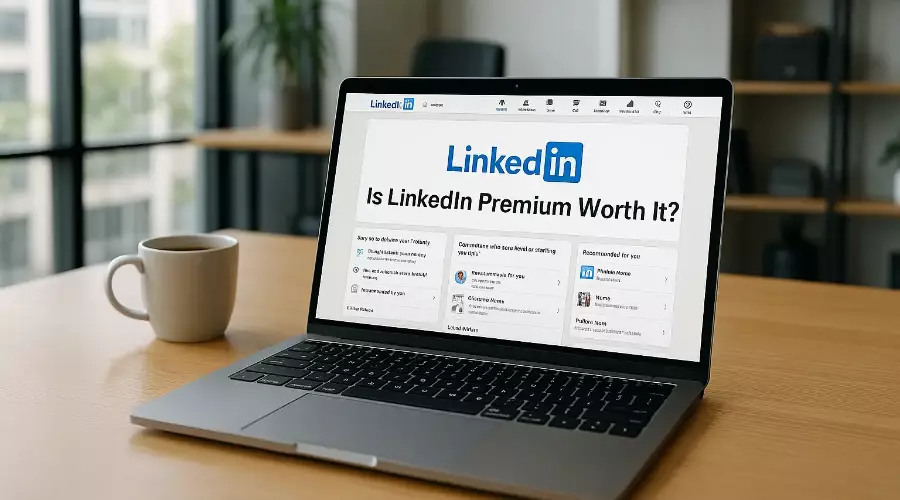Is LinkedIn Premium Worth It?

Let's be real: LinkedIn Premium isn't cheap. But if you know what you're doing and play to your goals, it can be a solid investment. Here's a clear-eyed look at what it offers - and where it falls short.
What You Actually Get with LinkedIn Premium
LinkedIn Premium is not a one-size-fits-all subscription - it's a set of distinct plans tailored to different professional needs. Premium Career is aimed at job seekers, giving them tools like advanced job insights, profile viewer data, and InMail credits to connect directly with recruiters. Premium Business caters to professionals and entrepreneurs who want to grow their network, offering expanded search capabilities, unlimited profile browsing, and detailed company insights. For salespeople, Sales Navigator Core delivers deep lead search filters, lead recommendations, and CRM integration to streamline prospecting and outreach. Meanwhile, Recruiter Lite is built for hiring professionals, offering enhanced candidate search tools, applicant tracking, and the ability to connect directly with top talent.
These tiers differ in both pricing and feature sets, so choosing the right one depends entirely on your goals. A job seeker who needs better visibility and recruiter access might benefit most from Premium Career, while a business development manager may find Premium Business a better fit for networking and research. Sales teams will see the most value in Sales Navigator Core's advanced lead targeting, and recruiters can leverage Recruiter Lite to speed up the hiring process. In short, LinkedIn Premium is designed to serve very different user profiles, and its worth is tied to how closely the features align with your day-to-day objectives.
Across all LinkedIn Premium plans, users gain access to a range of valuable features, including InMail credits that allow messaging people outside their network, advanced search filters for more precise targeting, full insights into who has viewed their profile, and, in some tiers, unlimited search capabilities. Additionally, subscribers benefit from LinkedIn Learning courses, interview preparation tools, resume insights, various AI-powered features, and detailed company information to support career growth, networking, and business development.
For example, with the Career plan, you get better job visibility, applicant comparisons, resume help, and learning content. Higher tiers like Sales Navigator unlock deeper filtering and lead tools.
The Cost - And Is It Justified?
Yes, it's a chunk of change. Premium Career typically runs around $29.99/month (or slightly more if billed monthly).
You're paying for tools that may or may not move the needle, depending on how seriously you're using them.
When It Actually Pays Off
If you're actively seeking a job - particularly in competitive fields - LinkedIn Premium can be a powerful asset. It boosts your visibility to employers, allows direct outreach through InMail, provides resume coaching, and offers learning resources that can sharpen your skills. Many users report that these features help them stand out from the competition and land interviews faster.
For sales professionals and recruiters, the value proposition can be even stronger. Tools like Sales Navigator or Recruiter Lite deliver advanced search filters, targeted lead recommendations, and enhanced outreach capabilities, making it easier to find, connect with, and convert the right prospects or candidates.
The Real-World View: Not All Positive
On Reddit, users are mixed - many job seekers say Premium didn't help much.
"LinkedIn Premium is not worth it for candidates … those features are probably not going to be moving the needle for you in your job search." - HeadlessHeadhunter
Some say the value depends entirely on how you use it - others say they'd never pay for it unless it was free.
Want to Make it Work? Use It Smart
- Try it free for a month, go all in. If you're not leveraging InMail, LinkedIn Learning, insights - cancel before you're charged.
- Be strategic with InMails - personalize them. Random messages get ignored.
- Use profile insights and resume tools to refine your approach to hiring managers.
- Stack it with other tools, to pull email addresses, automate outreach, and track metrics.
Start by taking advantage of LinkedIn Premium's free one-month trial and commit to using it fully during that period. Explore every feature, from InMail and LinkedIn Learning to profile insights, and see if they genuinely bring value to your professional goals. If you find that you're not making meaningful use of these tools by the end of the trial, cancel before the subscription cost kicks in.
When using InMail, be strategic and avoid sending generic messages. Personalizing your outreach by referencing a person's background, recent posts, or mutual interests significantly increases your chances of getting a response. Random, copy-paste messages are likely to be ignored and can even harm your professional image.
Make use of LinkedIn's profile insights and resume tools to fine-tune how you present yourself to potential employers or business contacts. These features can highlight what's working in your profile and where improvements are needed, helping you align your personal brand with the expectations of hiring managers or prospective clients.
Finally, maximize LinkedIn Premium's potential by stacking it with other professional tools. Combining it with email-finding or email verification platforms, outreach automation software, and analytics solutions allows you to extend your reach beyond LinkedIn, streamline your prospecting efforts, and measure the results of your networking and lead-generation campaigns.
Final Verdict: Worth It or Not?
- Yes, if you're seriously job-hunting, in sales, or recruiting—and willing to use the features.
- No, if you're casually networking, on a tight budget, or not making full use of the tools.
- Maybe, if you're willing to test it for a month, actually use all features, and see results—then decide.
LinkedIn Premium isn't for casual users. But if you treat it like a tool, not just a label, it can pay dividends. Use it aggressively, track your results, and pull the plug if it's not helping.



